

University of Minnesota Human Rights Library. Researching the Jurisprudence of the Inter-American Commission on Human Rights: A Litigator's Perspective. Richard J.

Wilson ** © Richard J. Traditional knowledge. Traditional knowledge (TK), indigenous knowledge (IK), traditional ecological knowledge (TEK) and local knowledge generally refer to knowledge systems embedded in the cultural traditions of regional, indigenous, or local communities. Traditional knowledge includes types of knowledge about traditional technologies of subsistence (e.g. tools and techniques for hunting or agriculture), midwifery, ethnobotany and ecological knowledge, celestial navigation, ethnoastronomy,the climate etc.
These kinds of knowledge are crucial for the subsistence and survival and are generally based on accumulations of empirical observation and interaction with the environment. In many cases, traditional knowledge has been orally passed for generations from person to person. Some forms of traditional knowledge are expressed through stories, legends, folklore, rituals, songs, and even laws. Other forms of traditional knowledge are expressed through different means.[1] Characteristics[edit] Indigenous intellectual property. Indigenous intellectual property is an umbrella legal term used in national and international forums to identify Indigenous Peoples' rights to protect their specific cultural knowledge and intellectual property.[1][2] It is a concept that has developed out of a predominantly western legal tradition of intellectual property law, and has most recently been promoted by the World Intellectual Property Organisation, as part of a more general United Nations push[3] to see the diverse wealth of this world's Indigenous, intangible cultural heritage better valued and better protected against perceived, ongoing thievery.[4][5] Declarations regarding Indigenous Intellectual Property[edit] United Nations Declaration on the Rights of Indigenous Peoples, September, 2007[edit] United Nations General Assembly 2003 Article 11: Indigenous peoples have the right to practise and revitalize their cultural traditions and customs.
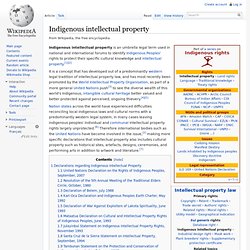
Declaration of Belem, July 1988[edit] 6. Public Agenda: (March 31st, 2006) Convention on Biological Diversity. The Convention on Biological Diversity (CBD), known informally as the Biodiversity Convention, is a multilateral treaty.

The Convention has three main goals: conservation of biological diversity (or biodiversity);sustainable use of its components; andfair and equitable sharing of benefits arising from genetic resources In other words, its objective is to develop national strategies for the conservation and sustainable use of biological diversity. It is often seen as the key document regarding sustainable development. The Convention was opened for signature at the Earth Summit in Rio de Janeiro on 5 June 1992 and entered into force on 29 December 1993. Environmental Audit - Appendices to the Minutes of Evidence. Bioprospecting. A white Rosy Periwinkle Bioprospecting is the process of discovery and commercialization of new products based on biological resources.
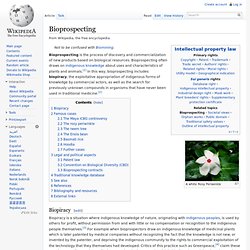
Bioprospecting often draws on indigenous knowledge about uses and characteristics of plants and animals.[1] In this way, bioprospecting includes biopiracy, the exploitative appropriation of indigenous forms of knowledge by commercial actors, as well as the search for previously unknown compounds in organisms that have never been used in traditional medicine.[2] Biopiracy[edit] Famous cases[edit] The Maya ICBG controversy[edit] The Maya ICBG bioprospecting controversy took place in 1999-2000, when the International Cooperative Biodiversity Group led by Ethnobiologist Dr. Indigenous and Tribal Peoples Convention, 1989. The Indigenous and Tribal Peoples Convention, 1989 is an International Labour Organization Convention, also known as ILO-convention 169, or C169.

It is the major binding international convention concerning indigenous peoples, and a forerunner of the Declaration on the Rights of Indigenous Peoples. It was established in 1989, with the preamble stating: Noting the international standards contained in the Indigenous and Tribal Populations Convention and Recommendation, 1957, and Recalling the terms of the Universal Declaration of Human Rights, the International Covenant on Economic, Social and Cultural Rights, the International Covenant on Civil and Political Rights, and the many international instruments on the prevention of discrimination, and Document[edit] The convention is made of a Preamble, followed by forty-four articles, divided in ten parts. Part I. Modifications[edit] Www.coe.int/t/dghl/cooperation/capacitybuilding/Source/documentation/hb09_rightfreedom_en.pdf.
Strasbourg Consortium: Freedom of Conscience and Religion at the European Court of Human Rights. Human Rights Concepts, Ideas and Fora. After introducing general aspects concerning human rights, the following part will deal with a number of substantive human rights in more detail.
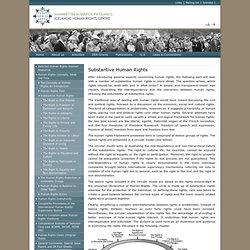
The American Society of International Law. European Court of Human Rights. Building of the European Court of Human Rights The European Court of Human Rights (ECtHR; French: Cour européenne des droits de l’homme) is a supra-national or international court established by the European Convention on Human Rights.
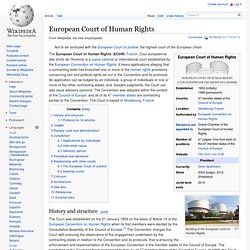
It hears applications alleging that a contracting state has breached one or more of the human rights provisions concerning civil and political rights set out in the Convention and its protocols. Freedom of religion cases international courts of human rights. Iachr sustainable development. Redirect Notice. Forest Law and Sustainable Development: Addressing Contemporary Challenges ... - Lawrence C. Christy - Google Books. Redirect Notice. Johannesburg principles on the role of law and sustainable development. WSSD: Johannesburg Principles on the Role of Law and Sustainable Development Adopted at the Global Judges Symposium held in Johannesburg, South Africa, on 18-20 August 2002. WSSD: Johannesburg Principles on the Role of Law and Sustainable Development Adopted at the Global Judges Symposium held in Johannesburg, South Africa, on 18-20 August 2002 We affirm our commitment to the pledge made by world leaders in the Millennium Declaration adopted by the United Nations General Assembly in September 2000 "to spare no effort to free all of humanity, and above all our children and grandchildren, from the threat of living on a planet irredeemably spoilt by human activities, and whose resources would no longer be sufficient for their needs",
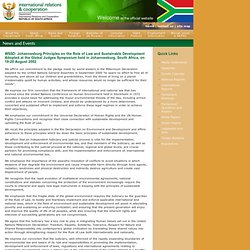
Www.wcl.american.edu/hracademy/mcourt/documents/218.pdf. Www.wcl.american.edu/hracademy/mcourt/documents/124.pdf. Inter-American Human Rights Moot Court Competition.